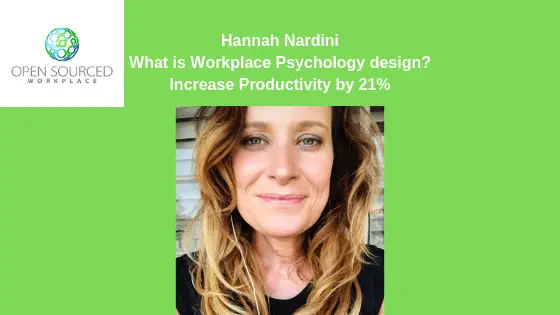Have you ever seen a beautifully designed office space that had areas that no one used? What is it that draws employees to one space and not another? Are there certain features that people turn away from? These questions, alongside numerous others, is what led workplace strategist Hannah Nardini to combine her knowledge of corporate interior design with occupational psychology. With the knowledge of both categories, Hannah has been able to marry them into one rare style of office design.
to combine her knowledge of corporate interior design with occupational psychology. With the knowledge of both categories, Hannah has been able to marry them into one rare style of office design.

Want to be interviewed on OSW – Sign up as a Service Provider Here 
How Hannah’s Background Led Her to Office Design
Hannah Nardini  discovered she had a unique ability in interior design, but ultimately there is a real need for natural talent to have a successful career. There are some things that just cannot be taught. However, it is important to have a teacher that is willing to work with your skills in order to gain experience and knowledge across a wide range of interior design areas.
discovered she had a unique ability in interior design, but ultimately there is a real need for natural talent to have a successful career. There are some things that just cannot be taught. However, it is important to have a teacher that is willing to work with your skills in order to gain experience and knowledge across a wide range of interior design areas.
The workplace is an area that people spend a large chunk of their lives, but the design of such an area is not something that is heavily promoted. The lack of presence in this area of interior design has led Hannah to a kind of blue ocean strategy kind of business. It is a business that encourages individuals to be more collaborate, attracts talent to a space, and is beneficial to both the employer and employee as a person. (Connect with Hannah on OSW – HERE)
kind of business. It is a business that encourages individuals to be more collaborate, attracts talent to a space, and is beneficial to both the employer and employee as a person. (Connect with Hannah on OSW – HERE)
Does Design Relate to Employee Retention and Satisfaction?
It might be challenging to try to draw a connection between how a space is designed and the company’s employee retention. However, Hannah explains that she makes an attempt to measure workplace happiness, general satisfaction, and productivity. Using a system to cut out biased opinions is part of the process used to measure these categories, but what is most important is the improvements that design can make.
In fact, with proper design, productivity can show a 21% gain. A gain such as this is not something that is achieved by doing every kind of space in the same design. What is needed is personalization and areas that allow people to work in spaces that work for their own personality. The design team must work with the people and the company culture to develop a space that works for them.
There are times when the company culture makes it feel as though employees are unable to use the breakout spaces that could contribute to productivity. Other times it is not necessarily the company’s guidelines, but the employee’s perception that makes them feel as though they must work at their own desk rather than the extra spaces. This comes from the management style, as perception should be handled from the top down.
Hannah mentions that it is important that both managers and design require personalization. There might be a cookie-cutter style of management and office design, but the most effective forms are when each employee is treated as an individual.
mentions that it is important that both managers and design require personalization. There might be a cookie-cutter style of management and office design, but the most effective forms are when each employee is treated as an individual.
Psychology and Office Design
Consider how an office design works for one person, but not for another. Hannah has a philosophy that workplace design should have psychology as a backbone. When it comes to designing an office space, it is not a good idea to simply take a picture of something that the company likes and mold it in the same fashion. Rather, offices should be created based on the business it houses and the people in it.
should have psychology as a backbone. When it comes to designing an office space, it is not a good idea to simply take a picture of something that the company likes and mold it in the same fashion. Rather, offices should be created based on the business it houses and the people in it.
Workplace psychology design requires stepping back and watching what happens in the office and interacting with the people that occupy the space. It is important to categorize people in areas of personality in a general sense. From there, a designer must consider noise and acoustics in a space to determine which personalities will work best in specific spaces.
Despite the topic being controversial, Hannah Nardini has no hesitation in bringing up the differences between males and females and the kinds of spaces that work for each gender. Even furniture varies based on the sex of the employee. Women are drawn to spaces like coffee shops that allow women to sit in softer seats and spend more time there. Comfort is something that is more important to women, but it is also important to know that women are more likely to sit there and accomplish less. There is a balance that must be found.
Designers must also consider the generations that are in the workforce at this time. There are baby boomers that prefer to communicate face to face and there are millennials that prefer to message the person sitting next to them. Understanding each generation is imperative for a designer that has to provide space for people of a wide range and the ways in which they differentiate. They must also be flexible and allow it to remain in motion over the years.
Instigate Change with Communication
Ensuring that people know how to use a designed space starts from the beginning of the design process. The leadership team must have a clear direction and open communication so that rumors do not start. However, communication must be done strategically. Specific information must be shared at specific times, as it is important to avoid overloading those learning of the change.
It is the senior employees that must act as role models and are the force behind the change, but the behind the scenes people that experience the change more so. The real change starts with the bottom. Every day employees that manage change well and quickly are referred to as Change Champions. It is those people that experience less anxiety with change and tend to simply go with the flow. The Change Champions must include a wide variety of people – from their job titles to their gender and personality types. These people are the ones that are put through the change curve before their coworkers.
For those that do not handle change well, the change curve is held off a bit. They experience such loss and emotional turmoil when it comes to change, that it is best for them to watch others go through it first. It also helps that the Change Champions have the ability to help them through the change. The Champions are trained and coached in handling certain situations and questions regarding the change.
Managers are also a part of change. In truth, they often make the biggest leaps to change. Early on, they must understand how to manage each person or each group when the new office design is being used. It is only then that the wider audience is communicated with portion by portion.
By instigating change in this way there is a level of support at each level of the organization. Hannah also explains that each level of the organization typically gets three cycles of the change. However, it is important that the process doesn’t take too long, as people will get bored with it. In order to hold on to the excitement, it is best for the change management process to last for 3 to 4 months, sometimes even less.
Psychology comes into play again as change goes beyond the first day of the new experience. Hannah also focuses on 6 weeks after the first day. On average, habits take 66 days to create. In order to get employees to work towards these habits, there much be coaching in work-related and non-work related aspects. This means culture, work processes, and more should be considered as a part of change management. Within change management, risk must be identified and mitigated.
Challenges in Location, Carbon Copies, and Employee Experience
Knowing the culture of the location in which Hannah is working is crucial to designing a working space. There are differences between Asian businesses and American businesses. Even differences between the UK and the United States are clear and require various qualities. If a global company had offices in multiple countries, it is impossible to pick up the office design and workplace that is working well in London and put it in a US city in the exact same way. Doing so will prove the variation that exists between the cultures.
is working is crucial to designing a working space. There are differences between Asian businesses and American businesses. Even differences between the UK and the United States are clear and require various qualities. If a global company had offices in multiple countries, it is impossible to pick up the office design and workplace that is working well in London and put it in a US city in the exact same way. Doing so will prove the variation that exists between the cultures.
Carbon copies are not a good way to maximize productivity. In truth, Hannah is a firm believer that although you may have done something the same way, doing it again and again is not going to last as a productivity maximizer. It might have worked in the past, but it will not last in the long run.
Instead of repetition, it is important that employees are provided with a culture of both trust and innovation. Provide the tools for change and the ability to use those tools. The tools should include the spaces that the employees have available to themselves. While that may make an impact on employee productivity, it will also have an impact on the employee experience.
Employee experience is also affected by an employer’s understanding of employee needs and what is needed to bring the best out of them. Communication is key. Action is also imperative. Once communication is shared, it is never good to hear the needs of employees and do nothing. Take action! Allow employees to be a part of the change and they will be at their best.
Watch Hannah’s interview on OSW HERE
Connect with Hannah on OSW HERE
Check out other OSW Interviews HERE
Want to be interviewed on OSW – Sign up as a Service Provider Here 

